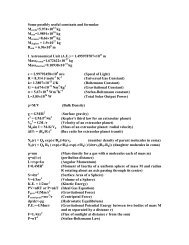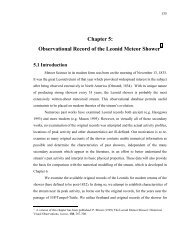Edwards W.N., Brown P.G., Weryk R.J., ReVelle D.O.
Edwards W.N., Brown P.G., Weryk R.J., ReVelle D.O.
Edwards W.N., Brown P.G., Weryk R.J., ReVelle D.O.
You also want an ePaper? Increase the reach of your titles
YUMPU automatically turns print PDFs into web optimized ePapers that Google loves.
Infrasonic Observations of Meteoroids 225<br />
more common than has been previously observed. Previous attempts at monitoring<br />
regional meteor infrasound at the Springhill Meteor Observatory (McIntosh et al. 1976),<br />
and by the Prairie Network (Kraemer 1977) resulted in only one confirmed sporadic meteor<br />
and one probable Geminid meteor infrasonic signal after *5 years of observation. Our<br />
current observations show that the flux is at least two orders of magnitude higher than these<br />
early observations suggest. We suspect that significant advances in computer technology<br />
and digital signal processing since the late 1970s and early 1980s, has likely made identification<br />
of these sometimes very weak signals (Table 1) far easier.<br />
The bulk of the observed detections in Table 1 tend to be from sporadic meteors. Some<br />
shower meteors, however, have been identified and include a suspected Orionid<br />
(20061021) and a confirmed Leonid (20061121) and Quadrantid (20070102). Additionally<br />
upon inspection of ray tracing geometry (i.e. deviation of the ray vector from the meteor<br />
trajectory), the observations may be placed into one of three categories:<br />
(1) Ballistic—rays which propagate approximately 90° ±20° (<strong>Brown</strong> et al. 2007) from<br />
the meteor trajectory, consistent with cylindrical blast wave theory (<strong>ReVelle</strong> 1976).<br />
(2) Quasi-ballistic—rays which border, but do not fall within, the ballistic regime (110°–<br />
125° deviation). Although often appearing to have ballistic shock features (i.e. N-type<br />
waves), these deviations are sufficiently large that they cannot be categorized as<br />
ballistic waves within uncertainties in the trajectory or model atmosphere.<br />
(3) Non-ballistic—rays which appear to emit from an omni-directional or point-like<br />
source (e.g. due to fragmentation or the blunt end of a meteoroid’s hypersonic shock).<br />
Having identified potential source mechanisms for the observed meteor infrasound, we<br />
attempt to reproduce the ballistic and quasi-ballistic observations using current theory<br />
constrained by the known trajectory & source regions (<strong>ReVelle</strong> 1974, 1976).<br />
4 Comparison with Theory<br />
The theoretical developments of meteor generated infrasound were developed initially by<br />
<strong>ReVelle</strong> (1974) based upon research in weak shock propagation and cylindrical blast waves<br />
and applying these to high altitude, hypersonic meteor sources. While initial treatments<br />
(<strong>ReVelle</strong> 1976) were based upon simplifying isothermal atmosphere assumptions, a<br />
method was provided as to how the theory could be extended to more realistic vertically<br />
inhomogeneous atmospheres (<strong>ReVelle</strong> 1974). Using a top down methodology, we use the<br />
ray geometry and the observed meteor trajectory, photometric mass and velocity to calculate<br />
the predicted theoretical signal overpressure (amplitude), Dp, and period using both<br />
an isothermal and vertically inhomogeneous atmosphere.<br />
Theoretical results for the nominal geometries for ballistic and quasi-ballistic observations<br />
are shown in Fig. 2. Theoretical uncertainties shown are the variation in predicted<br />
Dp and period accounting for uncertainties in geometry, mass and velocity. While predicted<br />
periods show similar scatter about the observed periods on the order of factors of 2<br />
or 3 for either model atmosphere (Fig. 2b/d), due to general insensitivity of the theoretical<br />
period on model conditions (see <strong>ReVelle</strong> 1976 Eqs. 15 and 34), predicted weak shock Dp<br />
show significant differences (Fig. 2a/c). Using an isothermal atmosphere, Dp is consistently<br />
underestimated by at least two orders of magnitude if treated as a propagating weak<br />
shock wave. A vertically inhomogeneous, however, (thermally stratified, range independent)<br />
atmosphere produces similar agreement in Dp as seen for period. Treating the<br />
propagating wave as a weak shock that transitions to a linear wave (not shown) produces<br />
123





